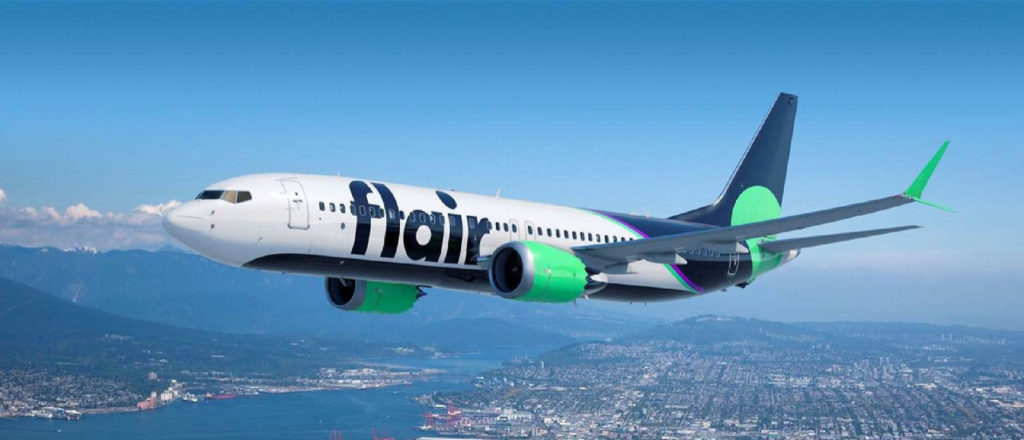Estimated reading time 7 minutes, 52 seconds.
Canadian ultra-low-cost carrier (ULCC) Flair Airlines is making headlines with its Feb. 10 announcement that it will add service to eight new destinations across Canada by August 2021 – bringing its total of Canadian destinations to 18. The announcement covers the schedule from May to October, but Flair CEO Stephen Jones said services could extend beyond that depending on performance.
The news of Flair’s expansion comes as Canada continues with “Phase 1” of its vaccine roll out plan; the airline anticipates an uptick in domestic air travel in the near term. “We’ve taken the view that by the summer, the provincial restrictions within Canada will be relaxed to the point where people will want to travel again,” Jones told Skies in an interview.

“When you’re growing an airline, you need some advance notice on things in terms of getting aircraft [and] hiring people. . . . Those things take planning,” he explained. Flair also recently announced, on Jan. 27, that it is adding 13 new Boeing 737 Max 8 aircraft to its current fleet of three 737-800s. The Max 8s, which will feature a new livery, will begin flying as the airline gradually introduces its eight new routes through the upcoming summer months.
“The first two [Max 8s] will be flying on May 1,” Jones said, when Flair begins service to the first four of its new destinations: Ottawa, Ontario; Kitchener-Waterloo, Ontario; Halifax, Nova Scotia; and Saint John, New Brunswick. On June 1, the airline will begin flying another two Max 8 aircraft, and will also add service to Thunder Bay, Ontario, and Charlottetown, PEI. July 1 and Aug. 1 will each see two more Max 8 planes take to the skies, as well as service added to Victoria and Abbotsford, British Columbia, respectively. This means eight of Flair’s 13 new Max 8 aircraft will be flying across the network by early August.
“Then we’ll pause [deliveries] for a while. . . . All 13 [aircraft] will be in before the end of the summer of 2022.”
For Flair, choosing the 737 Max 8 was a no-brainer. “We’re a Boeing operator already, so that makes it an easier transition if we’re going from one Boeing 737 to another,” said Jones. “But also, at the moment there were Boeing Max [aircraft] available at good prices in short notice — so we had good availability of a fantastically crafted aircraft at a decent price.” The airline will lease all 13 aircraft from 777 Partners.
While 737 Max aircraft recently received approval from Transport Canada to return to Canadian airspace — pending design changes to the aircraft and new training requirements — Flair said its pilots, maintenance professionals, flight attendants, and safety officers are conducting extensive testing and training programs.
Ultimately, the new Max 8 aircraft will allow Flair to “achieve the lowest cost-per-seat-mile of any Canadian airline.” The airline is on a “disruptive mission” to make travel affordable for all Canadians. What’s more, Flair intends to continue its growth beyond its recent announcements.

Domestic travel is a priority for the Edmonton-based ULCC, “because it’s about connecting Canadians at low fares,” said Jones. Many Canadian airports have seen drastically reduced traffic through the pandemic, as major Canadian air carriers continue to cut routes. Charlottetown Airport, for example, is currently down to one flight daily. Unsurprisingly, the news of Flair adding new destinations has received “fantastic response” from participating airports, Jones said. “People are hungry to see service develop again.”
But Flair will also “want to fly where Canadians fly to. . . . I know there’s a lot of north-south travel that’s currently on hold, but we would expect to be also building a north-south network.”
And with the potential to add more routes, the airline intends to add plenty more aircraft to its fleet, as part of a plan called “F50” — which stands for Flair 50. “We want to get to 50 aircraft within five years,” explained Jones. “It’s ambitious and bold, but it’s absolutely achievable. And we’ve got the business model right.
“I think it’s really important to focus on the ultra-low-cost business model as the underpinning piece to success here. So, by getting that business model right, we know that we can offer low fares and make good margins. And if we can do that . . . we will generate new demand, we will win market share, and we will enable ourselves to grow.”
As Canada’s only independent ULCC, Flair is not bound by the constraints of a parent company, Jones said. “We don’t have the overhead and costs associated with legacy organizations and networks, and this allows our efficiencies to be passed along in our pricing.”
As for Flair’s “F50” plan, Jones said there’s no exact science behind the number 50, but believes it’s meaningful relative to the size of the Canadian market. “There are about 220-230 narrow-body aircraft flying in the domestic market, and our view is that the ultra-low-cost segment will account for around 35 percent of that. So, we would hope to win the majority of that segment, and then add on top of that the international flights — so 50 [aircraft] feels about right.”
With 13 new aircraft already in the pipeline, the airline is well on its way to achieving F50.








